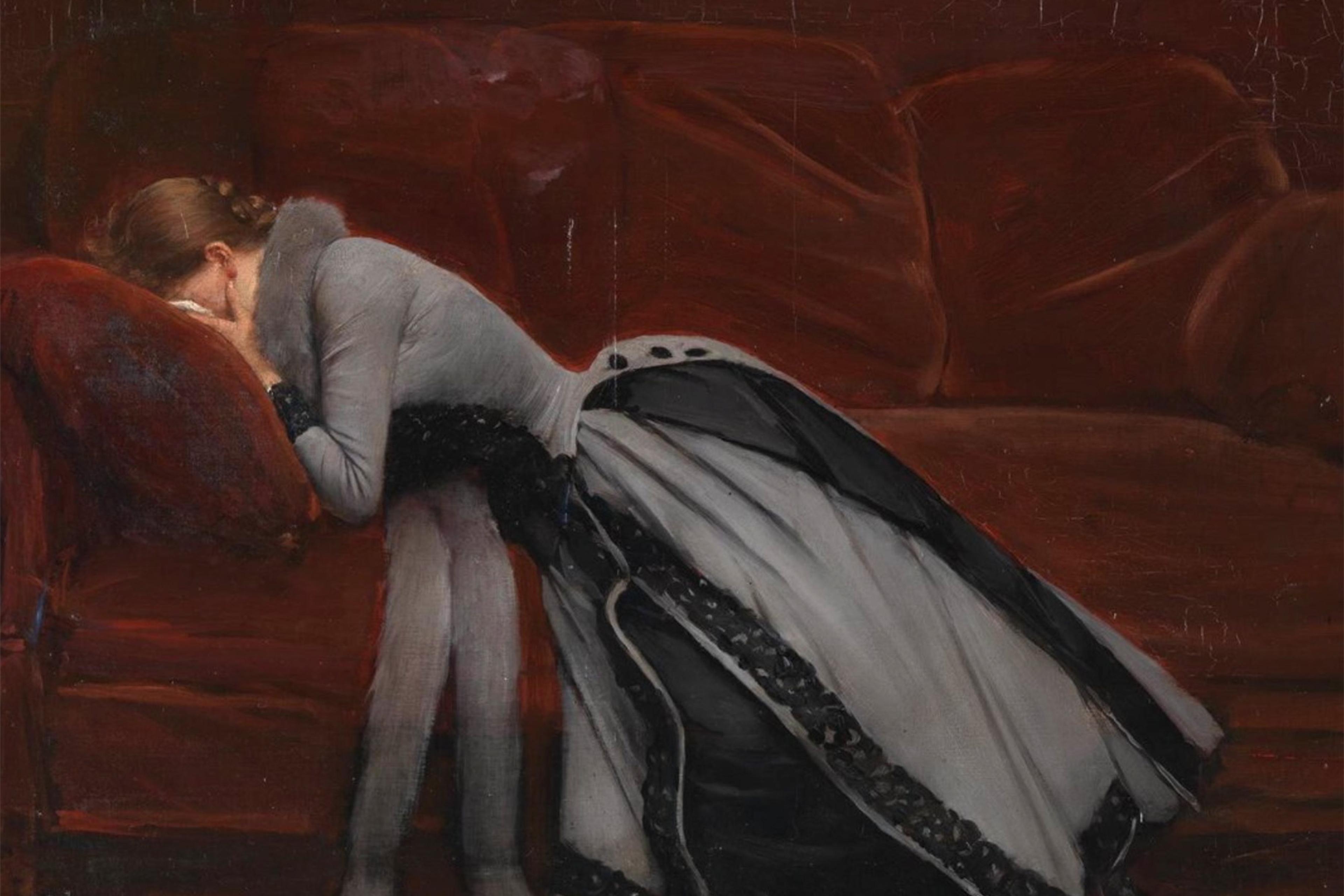It sometimes happens that we find ourselves looking in a mirror, berating our own reflection with a battery of insults. We remind ourselves about the awkward situations we created, how we failed to meet a mentor’s expectations, or the feelings of a friend we hurt. It can all be too much: we come to resent ourselves – we can even come to hate ourselves. What is this very strange emotion of self-hatred?
Self-hatred is, of course, a form of hatred directed at oneself, but it doesn’t fit the usual profile of hatred. Acting on hatred towards others often comes with pleasant, powerful feelings, but acting on self-hatred makes one feel worse. The difference between hatred and self-hatred is, as we’ll see, their respective relationships to shame. This is the fact at the heart of self-hatred that illuminates how we can mitigate such destructive feelings.
Philosophers analyse emotions at the conceptual level in order to better understand how they function and the roles they play in our lives. As we break down the elements of self-hatred, we’ll see how they work together and therefore how the process itself can be interrupted. Since self-hatred is a species of hatred, we first need to get a sense of what hatred involves. Hatred is a negatively valenced emotion that we can analyse by unpacking two components: its formal object and the paradigmatic behaviour it tends to cause.
The formal object of an emotion is the evaluative property it ascribes to the particular object the emotion is about. Fear, for example, evaluates objects like spiders (the particular object) as dangerous (the formal object). We get an idea of hatred’s formal object when we consider how it feels to hate. When you hate someone, you feel that they are defined by a negative trait (for example, greed) and that they have an unchangeable character. Through hatred, you have what the psychologist Carol Dweck calls a ‘fixed mindset’ towards the hated person. Hatred evaluates the particular object as incorrigible: it has negative traits without any redeeming good traits, and is unwilling (or unable) to improve.
When we hate the manipulative boss, for instance, we identify them with their manipulation, feeling that there is nothing good about them and that they won’t ever overcome their manipulative tendencies: these tendencies are baked in to who the boss is as a person. The central role of incorrigibility reveals that one way to overcome hatred is to accept that the boss can indeed change or recognise that they have some redeeming traits we weren’t aware of (they might be a caring parent). But, short of that, hatred will likely continue.
The paradigmatic behaviour of hatred is to harm the hated object. When you hate the manipulative boss, you find yourself with the problem of how to deal with an incorrigible agent. The philosopher Ingrid Vendrell Ferran reminds us that hatred also involves seeing the other as a threat to your self-worth. This threat can concern your physical and mental health, your image, or something you value. For instance, your boss’s manipulation dehumanizes you, threatening your value as a person. Furthermore, you cannot reason with them. To dissuade interaction with them, you harm them. You insult them, scratch their car, or quit on a day when your efforts are most needed. In extreme cases, this harm takes the form of bodily injury. Regardless of how it manifests, this harm comes with an empowering feeling: it feels good to defend your self-worth.
When you feel ashamed of yourself, you also feel that others would be justified in shaming you
How does this analysis clarify what is happening when hatred is directed at oneself? Self-hatred also involves evaluating yourself as incorrigible (the formal object of hatred) with a tendency to harm yourself (the paradigmatic behaviour of hatred). However, self-hatred lacks the powerful feeling that accompanies the harm. When you berate yourself in the mirror, listing all the reasons why you are worthless, you don’t feel powerful. You feel worse. After all, you’re evaluating yourself as incorrigible, as having no redeeming good traits. The core of self-hatred is this self-evaluation of incorrigibility. Once we understand what causes that, then we get a better idea of how to resist it.
Self-hatred arises from a nasty form of shame. So, what is shame? Shame is another negatively valenced emotion, the formal object of which is a person’s failure to live up to certain ideals. A student may fail to live up to the standards of their parents and so feels shame. Shame, like other emotions, targets an object that is different from what causes the shame. The student’s failure is an action (the cause) that is distinct from the student as an agent (the target). We have what is called a sense-of-shame which detects failures and targets agents in this way.
Shame’s target is not always yourself. Your sense-of-shame can be directed towards others as well – parents may be ashamed of their child for failing in school. The paradigmatic behaviour of shame differs depending on the target. If the target is yourself, then your paradigmatic behaviour is avoidance: you hide your face, avoid eye contact, try to escape the situation, and so on. If the target is another person, then your sense-of-shame may motivate you to exhibit similar avoidance behaviour (the parents may avoid looking at their failing child). Alternatively, your sense-of-shame may prompt you to engage in shaming: pointing out the failure, telling the other person that they should be ashamed of themselves, disassociating with them: the parents may point out the failure to the child and induce shame in her. When you feel ashamed of yourself, you also feel that others would be justified in shaming you.
Sometimes shame takes a more powerful form. You may feel shame for some fact about yourself that you cannot change. For example, you cannot change the fact that you hurt your friend’s feelings, and you cannot change the fact that you failed in school years ago. You can, however, try to hide from these facts. But hiding implies that there is some failure that you are hiding from, and this reminder catalyses another round of shame. The philosophers Thomas Scheff and Suzanne Retzinger describe this phenomenon as ‘loops of shame, of runaway self-consciousness … [giving rise to] feedback loops [of] unlimited intensities and durations.’ The psychoanalyst Peer Hultberg found this same phenomenon in a patient where the shame ‘became an almost global state which seemed to devour the girl’s identity; its overwhelming power threatened to dissolve her psychically.’ These loops of shame evolve to dominate the psyche of the agent. We can call this phenomenon dominating shame.
Loops of shame increase the intensity of the shame, but self-hatred hasn’t yet arisen. Dominating shame may lead to an internalisation of a negative self-evaluation but it’s missing that crucial ingredient of self-hatred: incorrigibility. To get there, we need to see how this kind of shame makes you feel like you have no redeeming traits in light of your failure.
The final step to self-hatred rests in the social side of shame, which involves metaperception. Metaperception is your perception of what another person judges about you. This is sometimes innocent. I look out at my students, I see their confused looks, and I assume that they judge my lecture to be perplexing. This metaperception helps me clarify things to help the students, and similar metaperceptions allow us to quickly correct our mistakes.
However, metaperception can be biased by self-esteem. If you have low self-esteem, you are more likely to think that others like you less, you are more likely to accept information that affirms your negative self-evaluations, and are more likely to assume that others easily see your negative traits. From your shame, you feel exposed to the negative evaluations of others; you feel constantly shamed by others for your failures.
Metaperception is powerful. It significantly influences the identities we form. The description under which I view myself seems to be highly informed by the evaluations I take others to have towards me. If I perceive that others judge me as a failure, then I am prone to identify as a failure or identify with whatever negative trait is considered a failure. When you suffer from dominating shame, you have regular metaperceptions of others judging you to be a failure. These build into a full-blown identity of a failure; I call this a shame-based identity. This is the last part of the story of self-hatred.
Resisting the loops of shame involves accepting that you have done your time
Putting together the above, self-hatred arises out of a combination of dominating shame and shame-based identity. In short, when you hate yourself, you likely had loops of shame that increased the intensity of shame, causing it to dominate your psyche. In addition to this, you feel shamed by others via your metaperceptions. Shame swamps any positive, redeeming traits you might have thought you had. As a result, you take yourself to be incorrigible.
Now we have an idea of what self-hatred is and what causes it, which gives us a few hints at how you can resist it. Notice how much needs to happen for self-hatred to occur: you need to have failed, to feel shame, to fall into loops of shame, to have metaperceptions of others shaming you, and to feel that there is nothing you can do to change your traits. You may find yourself habitually insulting yourself, harming yourself, or avoiding the satisfaction of your desires. None of the parts of self-hatred are irreversible. The key to fighting self-hatred is slowing down in order to interrupt the process.
Loops of shame in particular can be resisted. Perhaps you’ve done something that indeed merits shame. Even so, to feel repeated rounds of shame is too much. Resisting the loops of shame involves accepting that you have done your time: you felt shame for something shameful and need not continue feeling shame. Resisting biased metaperceptions works in a similar way. First, we need to appreciate that, when we feel intense shame, our metaperceptions are highly unreliable – it is likely that others are not shaming you like you think they are. Second, we need not endorse the shame we feel from others. Even if they do shame us, we are within our rights to say that they are simply mistaken, or that they are shaming us too much. Lastly, even if we endorse all this shame, we may be able to resist the globalising nature of hatred. This involves accepting that you have indeed failed but also recognising that you have other positive traits. You may have failed as a researcher, say, but you are still a good friend (and that is a redeeming feature). Accepting that you can improve on your bad traits can stop self-hatred.
Pulling all this off requires that we slow down and reconsider our shame and what causes it. We need to clearly identify what we feel shame for, whether this shame is merited, whether the failure truly defines us, and whether others are actually shaming us for it. And here we see the practical benefits of a philosophical analysis of self-hatred: without identifying each part of self-hatred, we cannot adequately slow down to break the process of self-hatred. As we properly identify the steps leading to our self-hatred, it may evaporate along the way.








